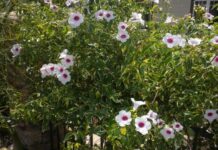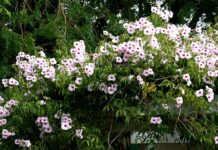
Echeveria Ramillette is a hybrid. It forms rosettes that have green leaves with red tips. This hybrid will produce amazing bell-shaped flowers. It grows mostly on rocky outcroppings and as a result, the water drains quickly. It grows best in the USDA zones from 9 to 11.
Below we will give you tips on how you can grow and take care of the Echeveria Ramillette whether you keep it indoors or outdoors. We will give you tips on how you can propagate it too. It is a beautiful echeveria that you will enjoy to have it either in your garden or in your house and why not in both places.
How to Grow Echeveria Ramillette
If you choose to grow a Ramillette from seeds you could do the following. Mix the echeveria seeds with fine talk or fine sand, use a small dish and make sure that you’ll use twice the seeds volume of sand or talk. What you’ll need to do next is to stir the mixture with a toothpick.
You will need to have pots about 4 inches with drainage holes. Add the potting mix in them. When you’ll add the potting mix make sure that it’s about the ¼ of the pot. Plant the seeds and the sand and use your fingers to spread it evenly over the soil in your pot.
You can use more than one pot. You can write down the date that you planted the seeds so as to know exactly the date and the time that you did it. Watering the seeds isn’t difficult at all. You need to water the bottom and make sure that the unwanted water will be in the tray.
Don’t place the pots with Ramillette seeds in direct sunlight, place them in partial shade. The temperature of the room should be around 65 degrees F. Make sure that the soil in the pot is moist enough because it shouldn’t be dry.
Once the first leaves appear search the plant for fungus. If you don’t find any then you can transplant them in your garden or you can keep them in the pots. Let’s have a look on how you can grow Ramillette indoors.
Growing Echeveria Ramillette Indoors
You can grow the lovely Ramillette indoors too. As far as it concerns the light, you will need to place it in a place in your garden that will be full of sunlight. During, the afternoon and evening it will begin to stretch out and you will see the magnificent rosette form. Don’t forget to turn the pot so as to have a symmetrical color.
The pot that you will choose must have holes and a tray in order to protect the Ramillette from rotting. The soil that you choose should be a potting mix that will provide drainage. You can add in the potting mix coarse sand that will help the soil with the drainage or you can buy a potting mix that will be specific for succulents and cacti.
Watering the Echeveria Ramillette won’t be a difficult task at all. You have to let the soil dry and then you’ll need to water it. This is the way to water it and don’t forget that the soil should always be dry before you water it. When you will water you should avoid the parts where the leaves are. If the water is trapped, it will create mold.
Water the Echeveria Ramillette below the rosette and make sure that the soil is wet. The holes and the tray will gather the unwanted water and in this way, your Ramillette will remain healthy. What’s great with echeveria is that it doesn’t require a fertilizer at all.
Echeveria Ramillette Care
Echeveria Ramillette will grow about 4 inches. It is quite easy to take care of it if you do it properly and follow our tips. Echeverias don’t do well in cold temperatures. If you want to have it in your garden cover it during the winter or keep it in a greenhouse that will also have heat.
If you keep Echeveria Ramillette indoors in the winter and you want to take it outside in spring do it gradually. Take the Ramillete out every day for a few hours that will gradually increase. In this way, you’ll be able to keep it outside.
If you live in a place during the winter than in the afternoon the sun and its light is hot this might have as a result for the leaves to get sunburn. In order to avoid it, you should provide partial shade to the Ramillette Echeveria.
Watering it is also an easy task. All you have to do is to make sure that the soil will be moist and not dry or too wet. You should always water the bottom and not the rosettes. You are the one that will decide when the best time to water the Ramillette is. Touch the soil and if it’s moist then you don’t need to water it.
Fertilizing the Echeveria Ramillette is a process that you can do every once in a while. You can boost it by using a fertilizer if you want to but don’t overuse it because it will burn the plant.
You can buy a slow-release fertilizer or one that is low in nitrogen mix or a cactus one. Be careful with the quantities, you can ask at the local store that you will buy it in order to be certain.
Echeveria Ramillette Propagation
The propagation of Echeveria Ramillette is quite easy. Once the seeds that you’ll plant create the first leaves you can cut them or you can use the stem cuttings. In order to propagate the ramillete you will need to use the leaf and place it with cacti mix and cover it until it forms new sprouts.
Once the new sprouts are formed you will be able to take them and plant them. You can follow this process every time you want to have new Ramillette Echeveria plants indoors or outdoors.
What is also great about it is that it can replicate itself. It produces several stalked chicks, as they call them, beneath their leaves. It can take from 18 months to 3 years for them to mature. It’s worth the wait.
Pests
As Echeveria Ramillette grows you should gather its dead leaves. If you leave them they will attract pests. Echeveria Ramillette is susceptible to mealy bugs which means that you need to pay extra attention to the plant. They are the most common pests that echeveria can get.
What the mealy bugs do is to spread easily and quickly from plant to plant. Overwatering and overfertilizing might be some of the reasons why they appear. What they do is to eat the succulent. They tend to hide at the stem where the leaves begin, that is why it is difficult to spot them.
You will find a web-like substance of white color on the leaves and you will also understand that you have mealy bugs on the Ramillette Echeveria if you notice that the plant is smaller than usual when it grows and it doesn’t have the same shape.
You can follow our tips in order to get rid of them. What you need to do is to move the plants that are affected in a separate area from the other ones. You can use a spray bottle fill it with 70% of isopropyl alcohol and spray them. Spray the echeveria until the mealy bugs disappear.
Another way that you can eliminate them would be to use dish soap and water. You can use a spray bottle once more and use it in order to spray the Ramillette Echeveria. Neem oil is a natural substance that will also protect your succulent.
You can use 1 ounce of neem oil with 1 gallon of water. Apply it during the night because if you do it in the morning the plant might be burnt because of the sun and the oil. You will be able to get rid of them and you will protect your beautiful Ramillette.
Echeveria Flower
Every year Echeveria Ramillette will produce amazing flowers. That will happen though if you take care of it properly. This means that you’ll need to water it when the soil is dry, to have the right light and what we already mentioned.
Most of the echeveria varieties bloom at the same period. That would be the end of summer. It depends on the variety; the wonderful blooms will last for a few weeks. During this period it would also be a good idea to pollinate them, it’s up to you.
Conclusion
Echeveria Ramillette is a wonderful plant that you can keep either indoors or outdoors. It isn’t difficult at all to maintain and take care of it. If you follow the tips that we mentioned in this article you will realize that it a great plant to have.
It will also produce amazing flowers that you will enjoy to look at. You can have more than one and you should make sure that they have plenty of sunlight. If you follow our tips you have this amazing plant for many years.







![Rose Names And All Rose Types – The Most Detailed Guide [2022] rose names](https://www.yardious.com/wp-content/uploads/2018/05/rose-names-100x70.jpg)











